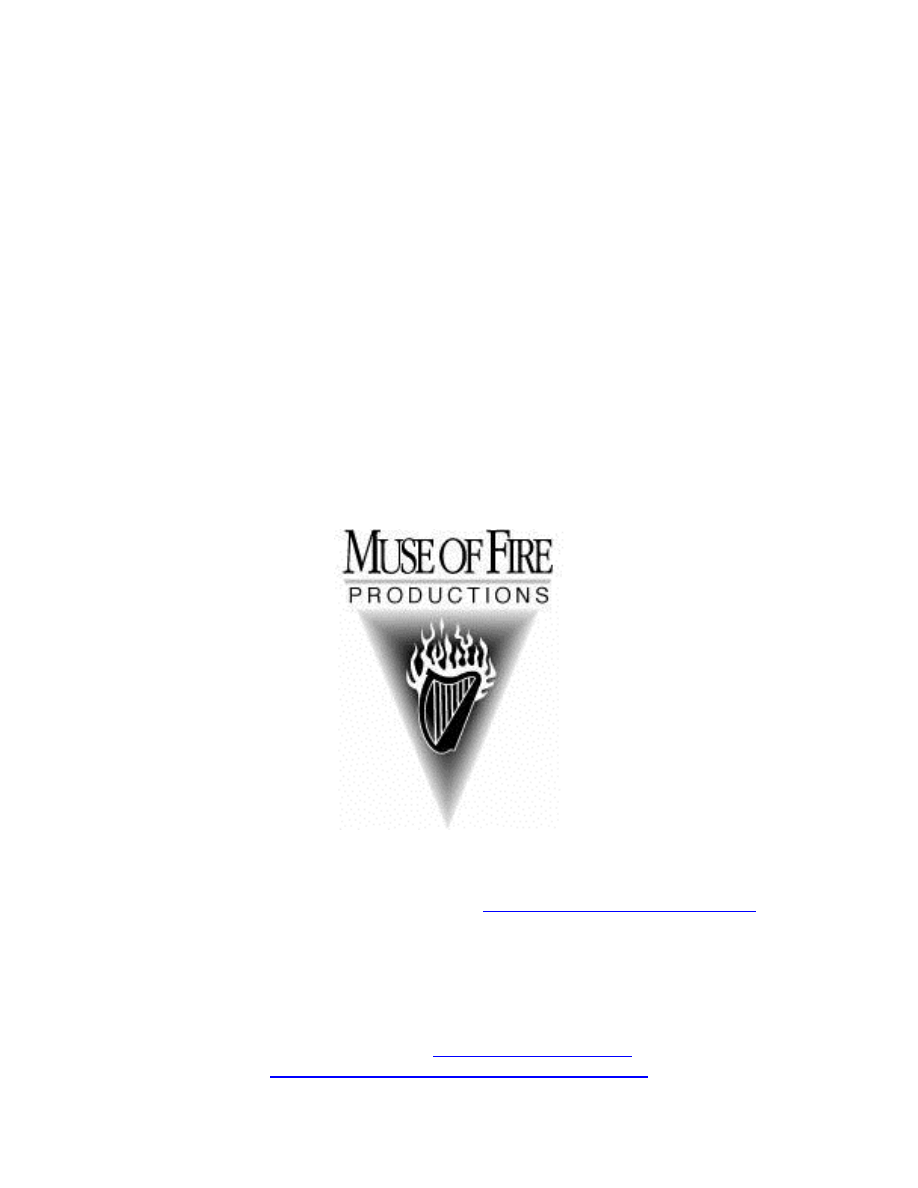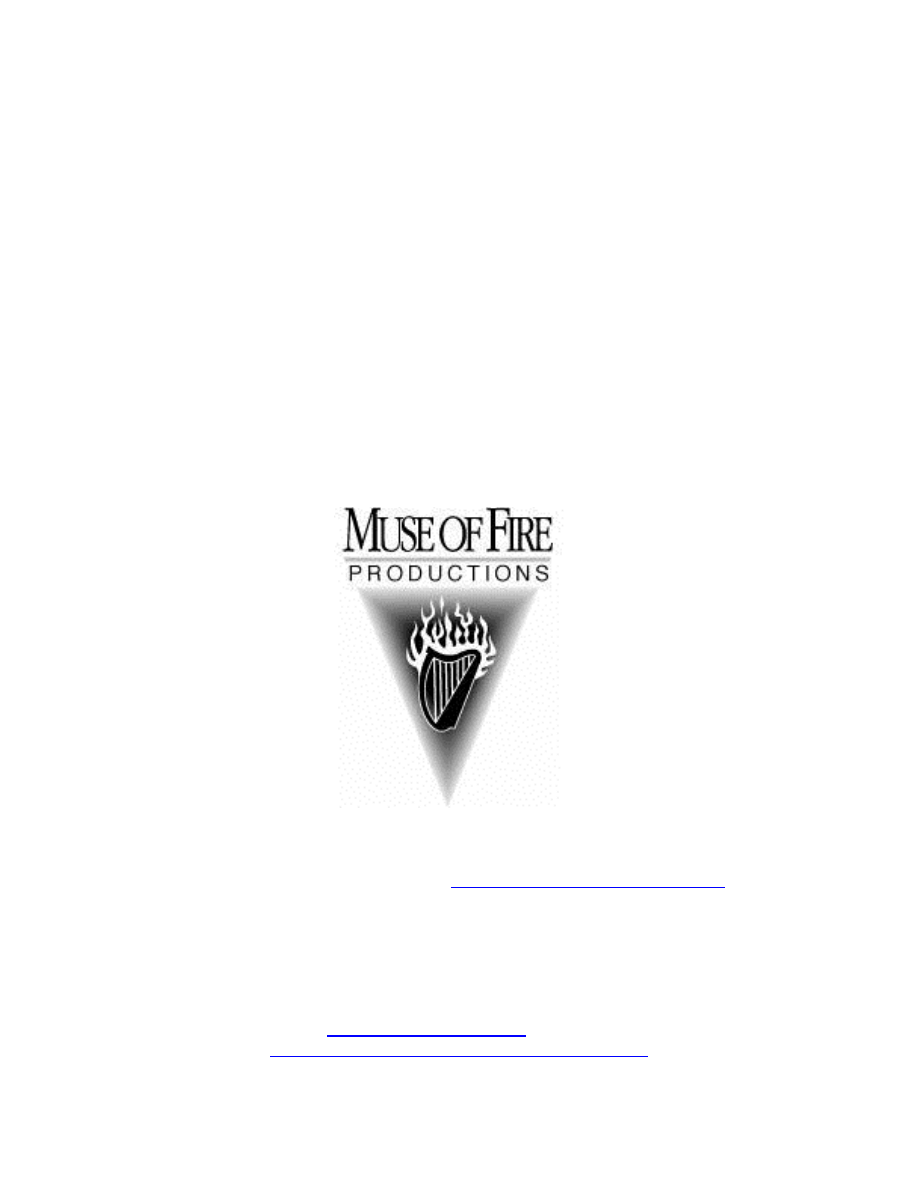
1
THE BRITISH SCREENWRITING
INSTITUTE
presents
Beginning Screenwriting
© Copyright 1999 by Alex Epstein
By
Alex Epstein
This is a wonderful introduction to screenwriting by a very talented American Writer. If you
would like more information, visit his web site at
http://www.loop.com/~musofire/
© The British Screenwriting institute. 2000-03-02. You may freely distribute this eBook on
line, upload it to newsgroups, or give it away.(Providing the contact and copyright
information is kept intact) Write to us at scripts@gofree.indigo.ie or visit our website at
http://www.thebritishscreenwritinginstitute.co.uk

2
Beginning Screenwriting
Here are some do's and don't's, according to me. I have made my living as a production
executive and screenwriter since 1990. I have read scripts, had them read for me,
optioned them, hired writers to write them and rewrite them, and tried to get actors,
directors and money attached to them. I've also written two dozen odd screenplays, seven
or eight of them commissioned, one sold but not produced, one produced, and one gone
into pre-production only to have the financing pulled. You don't have to take my word for
anything, but these may be helpful. Good luck!
Does Spelling Count?
You bet. And using a spell-checker isn't enough. If I see "your" for "you're" or "it's" for "its,"
I tend to recycle the script for scrap paper on the spot. Many people who read for a living
find it agonizing to read bad spelling, and assume anyone who can't spell is an illiterate.
Your Title
Your title is the most important single phrase in the script. A great title gets the script read
and the movie seen. A bad title can kill it. A good title also sets the tone for the whole
piece.
The best titles are allusive, hinting but not telling. As with everything in show business, sell
the sizzle, not the steak. The Lost Boys is infinitely better than, say, Young Vampires, not
only because it's a sly reference to Peter Pan, but because it alludes to, rather than
announcing, what it's about. Cool Runnings doesn't tell you it's a movie about a Jamaican
bobsled team at the Calgary Winter Olympics, but it is a happy title just offbeat enough to
make you want to know more. A Fistful of Dollars is gripping and brings to mind all the
things people will do for money.
Ideally your allusive title should also have a bearing on the movie, though it's not required.
The Good, The Bad and the Ugly tells you you'll see people do good things, bad things
and ugly things, and that's what the movie's about. It also describes the three main
characters. Crimson Tide is a scary image of bloody water flowing in. It is also the
nickname for the Alabama State football team, hence the nickname for the USS Alabama
submarine. Bodies, Rest and Motion suggests a thoughtful, philosophical piece. It also
gets to the heart of the story: some of the characters are stagnant, some are in motion.
A title that creates a mystery gets your script read. The Hunt for Red October instantly
raises the question: what's Red October, and why are they hunting for it?
Go to a bookstore (you remember, those things we had before Amazon.com?) and write
down the titles in the fiction section. Think about which ones grab you and why.
Commercial scripts often use phrases from popular culture, e.g. Point of No Return,
Internal Affairs, All the Right Moves, Nick of Time. Some writers keep lists of these for
future use. The danger here is that these titles come across generic. If I see a title like
Breaking Point, I think: what, couldn't the writer have thought of something clever?

3
You can get away with a title that is just a character's name, a place, something
descriptive, if you can't think of anything else, e.g. Platoon, Bridge over the River Kwai, Dr.
Zhivago. You're not helping yourself much, but you're not hurting yourself either. Note
though that names have their own magic. The right name sends a powerful message.
Zhivago sounds exotic. Kwai sounds alien.
A great title does not make a great movie, and a great movie can have a lousy title. It took
me a year to see The Shawshank Redemption because the title was saw godawful
heaviose.
You really can't spend too much time thinking up the best possible title.
Basic Screenplay Format
A lot has been written about screenplay format, much of it overly rigid. However, an
improperly formatted script is going to get chucked faster than a properly formatted script.
The basic points are as follows:
*
It must look typed. That means
no font other than Courier 12
. Not even on the
cover. No boldface. No justified text. No italics. Use underlining instead.
*
Title page has title and screenwriter's name(s) in the middle, and where to find you
(including your eddress) at the lower right hand. It does not have quotations, especially
not in a foreign language. Sorry. (Do not put your title on your cardstock cover.)
*
Never put a date on your script, or what draft it is.
*
No blank pages anywhere.
*
No second page with quotations, either.
*
No dramatis personae, i.e. no page telling us who the characters are and what
they're like. This is a theatre convention not used in movies.
*
First page starts with FADE IN:
Don't repeat name of script or screenwriter.
*
Margins are supposed to be 1.5 inches left, 1.00 inches right (to account for the
three-hole punch). Mine are usually 1.25 inches left, 1 inch right.
*
Sluglines take the form INT. JOE'S STORE -- BACK ROOM -- DAY or EXT.
GRASSY FIELD -- NIGHT (STORM). No underlining.
*
Descriptive text is about 60 characters (about 6 inches) wide.
*
Character names appear centered or indented over the character's dialog in all
caps. Diehards indent. Formatting software indents. I use centering, because it's prettier,
and because I'm not using a typewriter.
*
Parentheticals ("wrylies") are centered under name and over dialog; or again, for
diehards, indented.
*
Dialog is 35 characters, or about 3.5 inches, wide.
*
Where we hear the character speaking but they are not in the scene, you put (V.O.)
next to their character name to indicate Voice Over.
DECKARD (V.O.)
I don't know why he saved my life...
Where we hear them speaking and they are in the scene but not on camera, you put
(O.C.) to indicate Off Camera.

4
AMANDA (O.C.)
Darling, where did you put my boots?
She comes into the room carrying a pair of purple panties.
AMANDA (CONT'D)
And would you care to explain where these
came from?
This is sometimes written (O.S.) to indicate Off Screen. Either is fine. Where we hear the
character at the other end of a telephone, and they are not on screen, you put (filter) after
the name, to indicate their voice is off camera and coming through a phone filter. (It's an
awkward convention, but less awkward than (on the phone).)
JONES (filter)
Three hundred thousand bucks.
SMITH
But I don't have that kind of money!
Voices may also be heard (ON RADIO) or (ON TV).
On the other hand you may just want to introduce a new scene with INTERCUT WITH:,
meaning that the editor will cut between two simultaneous scenes as he pleases:
EXT. PHONE BOOTH - DAY
JONES (filter)
Three hundred thousand bucks.
INTERCUT WITH:
INT. SMITH'S BEDROOM - DAY
SMITH
But I don't have that kind of money!
If the character speaking is on TV you would write (on TV) after the character's name. On
the other hand if the TV is on in the background, just write something like
On the bar's TV, the Red Sox are getting clobbered again.
*
Where the same character speaks again after some scene description, you put
(cont.) in lowercase next to the character name. Otherwise the careless reader (that's
most of them) may assume your second character is responding. It's just a cue.
DEADEYE
So we'll hit the train when it comes around
the bend.
BANG! The door smashes open and Ranger Bob stands there looking mean.

5
DEADEYE (CONT'D)
So, Ranger Bob, you've found my hideout.
*
Where dialogue continues over a page break, you will need to repeat the character
name at the top of the page and add (cont'd) next to the character name. That's so we
know the character is still talking. Before I started using Final Draft, I used "cont'd" for a
page break and "cont." for continued dialogue on the same page. That's so it's easier to
locate the "cont'd"s when I repaginate. Note that (cont'd) or (cont.) are the only formatting
cues that belong in a selling script. A screenplay formatting program will put them in for
you, if you want to shell out for one.
*
Do not write "Title Sequence" even if you're writing something that obviously is a
title seqence, which you probably shouldn't. That's up to the director.
*
The first time a character appears in action, their name is capitalized: MABEL is
appallingly plain. or They plow smack into two YANK SOLDIERS and their
GIRLFRIENDS. This helps cue the reader (and the production manager) that we've never
met that character before. If a character first appears indirectly, such as in a photograph,
the name is not capitalized.
Again: in a selling script you should not put (MORE) at the bottom of the page where a
scene continues on the next page, or a (cont'd) at the bottom of the page where dialogue.
You should definitely not put (CONTINUED) at the bottom or top of pages where scenes
continue. These, along with scene numbers, are formatting cues used only in scripts that
are actually in pre-production or production, so that scene breakdowns can be done
efficiently. They only clutter up a selling script.
Here is
a page of a script
you can download in Microsoft Word for Windows format, using
my own personal formatting style sheet. You can easily
import the style sheet
from this
document using Format/Define Styles/Import. If you use the styles, you should have more
or less standard format. The styles use Keep With Next so that they won't break dialogue
over two pages unless the dialogue is four lines or longer, and where possible they
automatically send you to the next correct style. This means you have to do a minimum of
dinking (adding "(cont'd)"s) when you print your script out. There is probably a way to do
something similar in Wordperfect.
There are several programs such as
Final Draft
and
Scriptware
that will do your formatting
for you as you write the script. Final Draft seems to be the most popular and smartest
program. Script Thing is common in Canada, I guess so they can retain a sense of
national identity. No one seems to like Scriptor any more, and I can understand why.
Scriptware was kind enough to send me a review copy of their program. The manual is
clearly written. The program seems to be simple and intuitive to use.
In theory you can import a screenplay from any other program that allows you to save
your document as an RTF file, such as Wordperfect or Microsoft Word. Earlier versions of
the program effectively failed to do this, but you can
download the latest version from their
site
. The update still has some ugly bugs I hope they will fix (it inserts random spaces
which take forever to hunt down, and doesn't like "smart quotes"), but it does take an RTF
file and promptly and conveniently reformat it as a proper Scriptware file. The Scriptware
manual also claims that you can import a Final Draft file without going through RTF,

6
because Scriptware specifically knows about Final Draft. However, when I tried to do this,
Scriptware failed to recognize the file.
I am now using
Final Draft
a lot. It is much easier to import a Mac Word RTF file into Final
Draft. Assuming you have used a style sheet in Word, you simply have to tell it which style
is slugline, action, transition, parenthetical and dialogue. (If you have cunningly used these
words as names for the relevant styles, it doesn't even have to ask.) This is about a million
times better than Scriptor and Scriptware, which attempt to figure out styles from how you
have indented your Word file. Final Draft did have a problem, oddly enough, when the
same character speaks before and after a line of action; the repeated character name
imported as "general" style rather than "character name." But spending ten minutes fixing
these errors is nothing compared to the amount of time it takes to reformat the mistakes
other programs give you when you try to import an already-written RTF or text file.
Script formatting programs are crucial for a shooting script. When you are prepping a
picture, you need to be able to lock pagination, do "A" and "B" pages, OMITTED's, "X-
changes" and a lot of other things you need to know about when you're shooting.
Personally, I find that for a selling script, which is what you’re writing, a well-thought-out
Word
style sheet
will do 98% of what a formatting program will do. You can use all the
formatting and editing tools Word gives you, and not have to learn a new program. So you
can save the $250, or spend it on a good
script doctor.
.
Screenplay Length
Standard screenplay format clocks in at a page a minute. Exhibitors dislike any picture
over two hours. Think about it. They have two really busy shows on a week night, say at
7:30 and at 9:45. A longer show pushes the 9:45 past 10 pm, which is a psychological
barrier for people who have to work in the morning. Or, it pushes the 7:30 show back to 7,
which doesn't give people enough time to come back from work, put on jeans, eat some
dinner and go out for a movie. So the exhibs put pressure on the distribs (the studios),
who put pressure on the producers not to have overlong pictures.
Amusingly, Titanic went out listed at 2 hours 74 minutes, just so they wouldn't have to say
it was over 3 hours long.
So, a spec screenplay should be from 105 to 115 page. Anything over that gives them one
more excuse to reject it. If you have a subject of great epic scope (e.g. I wrote an
adaptation of The Odyssey), you can go over 120 pages, but anything over 125 pages is
asking for trouble. A 130 page script just looks and feels fat. After you've handled a few
thousand scripts, all printed on 20 lb. Xerox paper, you can easily weigh a script in your
hand and tell if it's too short or too long.
A low budget spec screenplay, something that is intended for straight-to-video production
under $2.5 million, should be 95 to 99 pages or so. Video distributors require movies to be
a minimum of 92 minutes long. More pages take more days to shoot, and days cost
money.
Comedy scripts may also be shorter. Comedy movies are rarely over 100 minutes long.
Woody Allen once said that that ideal comedy length was 87 minutes. On the other hand,
people talk faster in comedies, so you may need to break 100 pages in your script. Bear in
mind that a shorter comedy is easier to keep funny. If you have a comedy script that's over

7
110 pages, cut out the least funny 10 pages. Just don't cut out the emotional grounding of
the characters that make us care enough to laugh at them.
Television scripts for direct-to-television movies (DTVs, once known as MOWs, or Movies
of the Week), miniseries and one hour drama shows are essentially the same, except that
they mark where the teaser and acts begin and end. Sitcom scripts are quite different and
I couldn't tell you how to format them. A 22 minute sitcom script may be 50 pages long, as
I understand it. Action is off on the right, dialog to the left. Don't try to fake it.
The Windows version of the Courier 12 font is about 10% bigger than the Mac version. It
adds 10 pages to a script. There is some flexibility in the standards -- no one counts how
many characters there are in a line of dialog unless it is obviously overlength -- so don't
stress about it. This is only one of countless reasons I prefer Mac!
Don't use too many formatting tricks to shorten an overlength trick. It becomes obvious
really fast when the writer, instead of thinking how to tell his story more efficiently, has
changed font size or margins. Finish your script, and go back and start cutting.
How to Bind and Send Your Script
(This is the same information as my binding page, but not everyone goes there.)
Just like unorthodox screenplay format, unorthodox screenplay binding gets you off on the
wrong foot. Actually, that's putting it mildly. If your script looks substantially different from
all the scripts coming from the studios and agencies, then people know you're an amateur
and will treat your screenplay dismissively.
Screenplays should be on 3-hole 20 lb. paper, bound with two (not three) 1 1/4" folding
brass brads (ideally Acco #5 brads) with brass washers in back, and card stock covers.
You should be able to get brads and washers (known in the office supply industry as
"brass fasteners" and "brass washers") at your better office supply stores such as
Office
Depot
. #6's will do in a pinch. #4's and #7's are right out.
Staples
has Stockwell 1 1/2"
brass fasteners but no washers. You can also call Sure Source (800) 544-3243 or
Reliable Custom Shop (800) 877-6963.
Why two brads and not three? Because you only need two to bind a script, and when
you're making thousands of script copies a week, as the studios and agencies do, the cost
and time of putting in an unnecessary third brad adds up. See? You just saved 20 cents.
Covers should be card stock. You can get card stock at Kinko's or any other print shop or
paper store. Please don't use clear plastic covers. Please don't use 3" brads (too long) or
those skimpy #7 brads (they don't hold the script together). A few people use screw brads
("Chicago screws"), which I don't mind, but it immediately identifies you as out of the loop.
They also tend to be slightly too big for 120 pages. Please do flatten the sharp points of
the brads so they won't catch. Bashing the brads with a hammer will accomplish this nicely
if you have brass washers; otherwise, push the ends of the brads inwards as you fold
them, jamming the two legs of the brad together. Best of all, use pre-creased 9 1/2 x 11"
back covers that fold over and cover the points of the brads. Front covers that fold over
are a nice complement to these. My printer (L.A. Print & Copy, (310) 445 3200), made
fold-over covers for me out of my chosen card stock. If you're willing to pay shipping, I'm
sure they'd do the same for you. Really, you can have these made by any good print
shop; they just have to take a ream of 11 x 17 cardstock and cut 9 1/2 inches in rather
than 8 1/2 inches. This wastes the other half of the cardstock, but that's showbiz, Punky.

8
Please never spiral-bind your script or use those funny folding metal strips with sliders to
bind the script. Brads are the only thing used. Personally, I like to take the bottom brad out
when reading so I can flop the pages over. That's impossible with these systems. Not to
mention, have you ever tried to feed a spiral bound script into a copier? Ever tried to re-
bind a spiral bound script you took apart so you could copy it? It's a real pain.
If you are sending a script from another continent, try to get 8 1/2 x 11" paper if you can.
People are a little suspicious of scripts copied onto A4 paper. But if you can't conveniently
get standard American paper, it's not a big deal.
Xeroxing your title onto your cover is not done. Only pretentious people bind a selling
script in leatherette; if it's your copy of a shooting script for a produced movie you wrote,
that's a different story (Nick Meyer, are you reading this?).
The William Morris Agency was for a while copying scripts onto two sides of the page to
save trees, postage and schlepping, but it's not done any more. Many people find double-
sided scripts harder to read, so I wouldn't do it if I were you.
Don't put a copyright date on the script. It makes the script seem old when people read it a
year later.
However, do copyright it by registering it at the Library of Congress.
Sending your script
Priority mail (2 or 3 day delivery) is $3.20 for a script. The Post Office gives out free script-
sized 9 1/2" x 12 1/2" Priority Mail envelopes, made out of nice strong cardboard in
patriotic red, white and blue. Special Fourth Class Rate (Printed Matter) is a little less than
6 first class stamps. It'll get there in a week or two. It will generally take 4-12 weeks for a
company to read your script, so you might want to save the postage. I know you're excited
to send it, but they have a stack of scripts that are more urgent than yours, because they
came from people with whom they have relationships; so you may want to save a buck.
You do not need to use bubble-wrap envelopes. You do not need to protect your script
with file folders. Just a plain 9 1/2" x 12 1/2 envelope (or a Post Office Priority Mail
envelope) will protect it just fine. It's a pile of paper, for chrissake, it ain't bone china.
Getting it back
Some people like to include a stamped, self-addressed envelope (SASE) with their script.
Unfortunately, this does not help the producer, because the Post Office does not accept
stamped mail over one pound unless it is brought to a post office clerk who stamps it.
(This is supposedly an anti-terrorism measure, but of course its main legislative benefit is
to force everyone to lease postage meters from Pitney Bowes, as metered mail is still
accepted in mailboxes everywhere. I guess the idea is that terrorists may have access to
plastic explosives, but they sure don't have access to postage meters.)
I've never understood the point of getting scripts back, myself. It costs $3.50 to copy a
script if you shop around a bit and make enough copies, and $3.20 to put a stamp on a 15
cent self-addressed manila envelope, so if you get your script back you might save 15
cents. However, your script is probably smudged and coffee-stained, and you're getting it
back four months later, when you have rewritten it, or ought to rewrite it the moment you
get your script sent back with comments. What's the point? Let the producer recycle the
paper. No muss, no fuss, no bother.

9
Some companies will, as a courtesy, send your script back to you at their own expense.
Most don't, even when you are also an industry professional. Personally, I tend to mark
scripts up when I'm reading them, bend the pages over, occasionally even hurl them
across the room in frustration, so they're pretty well thrashed by the time I'm done.
Basic Style
In scene description, use short, declarative, visual sentences.
Avoid dependent clauses if you can. They're not visual; they convey a general sense of
what's going on rather than putting pictures in the reader's mind. This tells what's
happening:
While Tommy works frantically to adjust the steam valve, Nancy keeps lookout.
But this...
TOMMY
works frantically to fix the steam valve.
NANCY
stares nervously out the window.
...gives you two "shots," two mental pictures. It shows what the other version tells.
This style has the advantage of creating lots of white space on the page. Readers often
skip dense blocks of text. That's right. They just blip over them.
Every moment in a screenplay takes place now. So avoid any time constructions, such as
clauses that use the words "while," "before," "after," "when" or "then." Don't write:
After Sandra has been sitting here for a while, she sighs. Then starts yawning.
Nobody's going to put "after Sandra's been sitting here for a while" in a movie, because
we don't want to watch anyone sit anywhere for a while, not even Denise Richards in a
sheer bikini.
However, you can use a time-related concept, when it's really visual shorthand:
Sandra sighs, frustrated. She yawns. She's been sitting here for hours.
In this case the time-related phrase puts a visual impression in your mind, not a concept.
We all know what people look like when they've been sitting somewhere for hours: tired,
frustrated, bored, slumped but not really relaxed or comfortable.
Avoid the present participle ("is walking") if you can possibly use the simple present
("walks"). The exception for most writers is where a definite action interrupts an indefinite
one:
Tommy is walking along the street when a thug comes sailing through a shop window and
lands at his feet.
But in my book, you can write this scene more visually in the simple present:
Tommy strides merrily along, whistling a happy tune-
SMASH! A thug comes sailing through a shop window and lands at his feet.

10
As with all good writing, use the active voice ("the door slams open"), avoid the passive
voice ("the door is slammed open"). I can't think of any exceptions to this one.
Obviously, there is no "basic" style for dialogue. That is entirely an outgrowth of character.
Not all characters should be terse. Not all dialogue should be snappy, unless of course
you're writing "Buffy: The Vampire Slayer." However, it is risky to write boring dialogue
even when the character's supposed to be boring. 'Cause, duh: it's boring.
No Camera Direction
Please never direct explicitly the camera in your script. It's annoying. It destroys the
reader's attempt to imagine the movie in his own head. It is as if you put the film crew on
the screen instead of the film itself. In other words, don't write:
CLOSEUP OF FEET
walking along the floor. We TRACK ALONG WITH the feet until they
disappear...
This, however, works:
FEET
walk across the floor and disappear behind a door...
I call this a "virtual closeup". The reader "sees" only what the writer wants him or her to
see. But the reader is not thrown out of the "movie" he is imagining in his head by your
idea of what the director ought to do. The director will probably ignore you anyway.
Don't direct camera, even indirectly, if it's not important to a scene. In an action scene you
will want to convey as much visual information as you can put in without slowing the pace.
But in a dialogue scene, it may be unimportant how the camera moves. The dialogue and
the acting are telling the story. The director will hopefully try to add to the scene by his
crafty framing and movement, but unless you've come up with a shot so clever it is telling
the story, I would keep your dramatic scenes clean.
As a general note, try to write the scene so that the visuals tell the story, not the
dialog. What we see is often stronger than what we hear. According to his book
Screenwriting Tricks of the Trade, Bill Froug suggests that, as an exercise, before you
write a scene, you try to imagine how you would write it if you were making a silent
movie.
This is not to say that dialog is somehow a poor cousin to cinematography, although some
pure cinema fans (and a lot of eclair-stuffed claret-sodden French critics) might think so. It
would be just as possible, theoretically, to have an entire movie that takes place in the
dark with people talking, as to have an entirely silent film with no dialogue. It's just that a
writer's impulse is often to put dialog everywhere. The less dialog you have, the more
effective each line is. Your actors' faces will be 40 feet tall on the screen. Trust them to get
their feelings across with a minimum of dialog.
However, this applies only to dialog that does things, where the characters move, or
attempt to move each other with their words. Dialog that merely refers to events is much
softer than seeing the events. An argument is as good as a chase scene. But if you have

11
a character tell us about something that happened, it is perhaps only a fifth as effective as
showing us a flashback.
If you want the audience to know a plot detail, you generally are going to have to show it
to them. They may miss a throwaway line about an ice pick entirely, but they're not going
to ignore the ice pick underneath the bed if you show it to them.
On the other hand, you can use the relative softness of dialog to filter scenes that would
otherwise be over the top. There is an extremely effective scene in Jaws in which Robert
Shaw's shark hunter character Quint talks about the sinking of a US battleship at the end
of World War II. He conjures up the screams of the dying sailors as sharks tore them to
bits in the water. There is no way we'd want to see that on screen, even if you could afford
to shoot it.
I never want to see someone's dog die on screen. But you could have a really powerful
moment where a kid talks about seeing his dog die on screen.
You'll also want to use dialog when what's important is how the character feels about the
event, not the event itself. In A Fistful of Dollars,, the husband asks the Man With No
Name why he's risked his life to get his wife and child back. The Man With No Name rasps
out, "Because once there was a family like yours ... and there was no one to help." We
don't need to see what happened to the Man With No Name's family; we only need to
know how he feels about it.
Another place to use dialog is where what's important is that the character is telling the
story to someone. For example, if a guy is telling his deep dark secret to a girl he's just
met, the secret isn't so important as the dramatic event of the guy telling it to the girl.
To really see the tension between dialog and cinematography, as an exercise, write a 10
minute screenplay that takes place in pitch blackness, then write a 10 minute screenplay
without dialogue...
This leads to ....
Only Write What You Can See and Hear
Some beginners write lines of description like this:
INT. O'BRIEN HOUSE - KITCHEN - DAY
The O'Brien family has just moved into their new house, a small brick
bungalow outside Santa Barbara, but it hasn't helped. They've been on
each other's nerves for days.
What we will actually see is some people in a kitchen. How will we see, as written, how
long they've been in their house, or what it looks like on the outside? How will we see
they've been on each other's nerves? The audience won't be reading your description, will
they?
Some beginners put lines like that into the script to tell them what the scene's about as
they're writing. Fine. Put them in, write the scene, take them out. Other beginners expect
those lines to carry the scene. Not acceptable.
You must stick to what you can see and what you can hear. The devil is in the details:

12
EXT. O'BRIEN HOUSE - DAY
A small brick bungalow with dead grass and two stunted palm trees. Dull
green mountains in the distance. Somewhere, SEAGULLS complain.
INT.
O'BRIEN HOUSE - KITCHEN - DAY
Some boxes have been shoved to one side, power cords hanging out of
them, to make room for three days' worth of dirty dishes. More boxes
on the floor. The faucet is dripping. Amanda storms in, starts
clattering the dishes into the sink.
CATHERINE(O.S.)
Amanda!
AMANDA
I'm doing them!
CATHERINE (O.S.)
Aman-da!
Amanda clatters the last plate into the sink, runs to the dining room side.
AMANDA
I hate this house! I hate it!
I hate it! I hate it! Why'd we
have to leave?
She runs out the other end. The front door SCREECHES open and
SLAMS shut.
Catherine slumps in. Tosses her cigarette in the sink. To herself:
CATHERINE
I hate it too, honey. But it's just
for a little while.
Here the "set design" is such that anyone would feel miserable in the house, and sure
enough, they do. But I haven't written anything you can't see or hear.
Notice how I've broken up the paragraphs of action. This suggests individual camera
angles without distracting. It also helps the format achieve the page-a-minute standard
that production managers love.
Breaking up action paragraphs is particularly important when describing an action
sequence. A big chunk of solid text is practically unreadable. Break your paragraph shot
by shot, if it feels right:

13
JOE hits the ground rolling, firing the .45 BAM! BAM! BAM!
as he rolls-
STEVE takes a slug in the gut, smashes backwards through the
window, glass shattering-
...falling...
...falling...
-CRUMP! Steve slams into a car roof, bloody, arms sprawled
awkwardly.
You probably "saw" Steve fall in slow-motion. Good. That's what I wanted.
***************************
PART TWO of
Beginning Screenwriting
by
Alex Epstein
follows. Chat on the Original
SCREENSPEAK FORUM at
http://www.thebritishscreenwritinginstitute.co.uk
***************************
This document is © Copyright 1999 by Alex Epstein, all rights reserved. It may be freely
quoted and / or copied, provided I am properly cited, and this copyright notice is not
removed. Permission subject to revocation by author without notice….
Muse Of Fire Productions is at
http://www.loop.com/~musofire/

39
THE BRITISH SCREENWRITING
INSTITUTE
presents
Beginning Screenwriting –2
© Copyright 1999 by Alex Epstein
By
Alex Epstein
Dear All..this is a wonderful introduction to screenwriting by a very talented American Writer. If you
would like more information, visit his web site at
http://www.loop.com/~musofire/
©
The British Screenwriting institute. 2000-03-02.
You may freely distribute this eBook on line, upload it to
newsgroups, or give it away. (Providing the contact and copyright information is kept intact)
Write to us at scripts@gofree.indigo.ie or visit our website at
http://www.thebritishscreenwritinginstitute.co.uk

39
Beginning Screenwriting – Part Two
Cut To's and William Goldman
In between every scene (not every shot), you put "CUT TO:" in your right margin, with a
space before and a space after.
After the "CUT TO:" comes a slugline that looks like this:
INT. JOE'S BARN - LOFT - DAY
The CUT TO: says you're in a new scene. The slugline tells the reader where the new
scene takes place.
What's a new scene? A good rule of thumb is that when you jump from place to place, or
from time to time, it's a new scene. So, for example, if two people are talking in a room,
and then you cut to them continuing the argument in a car, then it's a new scene, and you
would indicate the change in scene by a CUT TO:. However (and this is how a selling
script would differ from a shooting script), if they walk out of the room, still talking, and into
the car, and drive off, still talking, then it would not be a new scene and you would not put
a "CUT TO:" between them. (In a shooting script, you would, because you might shoot the
interiors and exteriors on different days at different locations. But you're not writing a
shooting script..) Note that though you do not use a CUT TO: when the scene is
continuing in different parts of the same location, you still put a new slugline. So, for
example, between an exterior and an interior, you would not use a CUT TO:
EXT. JOE'S BARN - DAY
The Creepy Guy sneaks inside.
INT. JOE'S BARN - DAY
The Creepy Guy sneaks up the stairs. They CREAK.
INT. JOE'S BARN - LOFT - DAY
Joe waits, hands on his revolver.
All of these actions are taking place in the same place and time, and they're all connected.
Save your CUT TO's to emphasize when you're leaving the place or time.
By the way, if it is a very small jump in time, I don't bother with a CUT TO:, for example if I
show someone entering a building and then have a dialog scene in that building, I won't
use a cut to, even if I start the dialog scene in the middle of the conversation:

39
EXT. WHITE HOUSE -- DAY
A limo pulls up in front of the gate.
INT. WHITE HOUSE -- OVAL OFFICE -- DAY
SAM
... Mr. President, I understand what
you're saying, but it was only a three
hour cruise. We have to presume someone
didn't want Mr. Howell to talk to us.
This is my style, anyway. There are various schools of thought regarding CUT TO:'s.
Shooting scripts have lots of them, selling scripts few of them.
A few people don't use them. I guess they feel they clutter up the page, or they're old hat,
or something. Speaking as a development executive who's read thousands of scripts, I
find that when I'm reading a script without CUT TO:'s, I can be halfway through a new
scene before I realize I'm in an entirely new location or at a later time. Careful readers
don't need them, but then neither do elves, Santa Claus or the Easter Bunny.
Where you have a conversation taking place between two people on the phone, you
probably do not want to indicate exactly how to edit the conversation, as that would get
distracting (and anyway, your reader will ignore anything you write and just read the
dialog). The way to do this is with INTERCUT:, which you put where the first CUT TO:
would go:
INT.
JOE'S BARN -- GROUND FLOOR -- DAY
BRRRING! The Creepy Guy pats his clothes, brings out a cell
phone, opens it.
CREEPY GUY
Yeah?
INTERCUT:
INT. SCHRECK'S OFFICE - DAY
Schreck wheezes into his phone.
SCHRECK
Come on back home.
CREEPY GUY
Boss, I got him cornered!

39
SCHRECK
Come on back, now.
Schreck looks up at Ellen, who is pointing a silenced pistol at him.
Schreck and the Creepy Guy are not both in the barn, but you don't want to clutter a
simple conversation with a lot of visual editing that no one's going to use, anyway.
In a "selling script" (any script not actually in production), do not number your scenes. It's
distracting and pretentious, suggesting it's so perfect it's a shooting script.
Bill Goldman
is famous for not using sluglines, for example in Butch Cassidy and the
Sundance Kid. He just uses CUT TO's. The script reads like a breeze, with a wonderful
sense of energy and movement.
The essential problem with the William Goldman style is that it is excellent at
communicating tone without telling the filmmaker very much about what actually is going
to be shot, thus encouraging handwaving.
It is the sure sign of a beginner to use this format. It is irritating and unprofessional. When
I was on a production at Hollywood Pictures, an extremely overpaid writer handed in a
script in this format. We had to have an assistant go in and add the sluglines back, at
which point the script turned out to be not ten pages too long, as we'd thought, but twenty
pages too long. In the end, the studio not only junked this script, but refused to show more
than a few pages of it to any later writers.
Do not use this format until you are William Goldman, or paid like him.
Character Names
When you give a character a name, you give him or her flesh. I'm really finicky about what
names I give characters. I feel they should project their personality if at all characters.
They need to be real enough names to be believable -- nobody named "Daedalus" please,
unless it's a nickname the character consciously has -- but they should tell us something.
BOB is an ordinary guy. JOEY is an ordinary working class guy. ERIC has an edge.
There's something sexy and daring about a girl named DAKOTA. MR. FINSTER is a
kindly grocer the kids make up rhymes about. And so on.
I don't give all characters names. I find it's useful to leave secondary characters with a
descriptive monicker rather than a name: LONER. That way the reader knows she won't
have to keep track of them later.
On the other hand, never name characters THIEF #1, THIEF #2. Make them FAT THIEF
and SNEERING THIEF. That puts an image in a reader's head.
For bonus points, you can sucker the reader into thinking someone's not important by not
giving them a name. Then later, when LONER -- surprise! -- starts dating the heroine, he
becomes NICK THE LONER for a few lines until we know he's NICK.
Apparently some people feel the reader should never be fooled, "A character should
always be called what he's going to be called ultimately, even if he looks, at first, like an
extra who just happens to be near the action."

39
I find that many professional screenplays have characters named DARK-EYED MAN that
later turn into DR. CZERNY. The writers want to give the reader the same feeling the
audience will have: who the hell is this dark-eyed guy? I am sure this practice gives
production managers ulcers, but you're writing a selling script, not a shooting draft, and
they're paid to have ulcers.
(Okay, I can't resist. You of course recognized instantly that "czerny" is Czech for "dark,"
as in "czerny pivo," "dark beer." That's the sort of thing I amuse myself with during dark
and stormy nights...)
Avoid giving female characters male names. It's hard to remember that SAM is really
Samantha. Avoid KIM and LESLIE as men's names for the same reason. For some
mysterious reason, even professional screenwriters like to have female characters named
JOEY ("Dawson's Creek") and CHARLEY (The Long Kiss Goodnight). They think it gives
the character guts. Please find another way to do it. Sarah Connor was totally buff in
Terminator 2, and she was still "Sarah."
Never use a name that's hard to read or pronounce. It's a distraction. So "Llewelyn" is out.
So is "Kjersti Kyrkjebo." (You think I'm kidding?)
Be careful with foreign names. Even when I don't know the language in question, I can
usually tell when someone's made up a name from scratch. The audience knows a lot of
things it doesn't know it knows. One of them is what names sound like, even names from
strange countries. If you can, take real names from the country in question, and mix up
first and last names. Don't use very famous names (Gandhi) unless your character makes
a joke about it. How do you get real names? Look in the almanac and find out who was
the Minister of Transportation, or look in the Encyclopedia Brittanica and pick out names
from the country's history.
Another good way to get foreign names is to get a map of the country and use a place
name, or to use a foreign word. Believe me, no one is going to know that Arusha is a
place in Masai territory and not the name of a Masai, or that Shikari is Sanscrit for
"hunter."
Believe it or not, when you're writing fantasy, you still can't get away with entirely made-
up names. Names like "Morlock" and "Gandath" always betray themselves for fakes,
generally fakes based on the "Lord of the Rings" trilogy by the great J.R.R. Tolkien. How
did he make up his names? Believe it or not, Gandalf, Gimli Gloin and many of the other
names come right out of Old Norse and Old English. He didn't make them up, he stole
them. Other names, such as Galadriel, he made up using elements from High Elvish, a
language he had painstakingly invented based loosely on Finnish with all the gutteral
sounds taken out. Tolkien was a philologist (a scholar of languages) at Cambridge
University in England; he claimed he invented the Lord of the Rings to justify having made
up a lot of languages for fun, his "secret vice." If you are a professional linguist (Mark
Okrand, are you reading this?), you too can make up names from scratch. Otherwise, try
names from African, Native American or Far Eastern languages like Tibetan and Uzbek.
Science fiction names should follow foreign language rules for human names and fantasy
rules for alien names. Human names have not changed much in the past four hundred

39
years, and they are probably not going to change a hell of a lot in the next few hundred
years, any more than jambalaya is, if you think about it.
Wrylies
Also known as "parentheticals," these are those little parenthesized instructions to the
actor that come between the character name and their dialog. They have several obvious
uses, for example when a gesture is not worth giving a whole line of action to:
JOE
(shakes hands)
Been a long time, huh?
(Note: these examples are not necessarily properly formatted. That will depend on your
browser.)
They are also used to tell how the line is to be delivered:
JOE
(irritated)
Glad to see you.
They are not to be used when the line is obvious:
JOE
(angry)
You bastard! I'll kill you!
Duh. Of course he's angry. Just cut the wryly in this case.
They are not to be used because the screenwriter is too lazy to come up with a line that
expresses the right emotion:
JOE
(wryly)
Been a long time.
The frequent overuse of the parenthetical instruction "wryly" is why they get called
"wrylies." The line should be rewritten:
JOE
And here I figured you'd be a dead son of a bitch by now.
The best use of the wryly is where the meaning of the line in context is the exact opposite
of the usual meaning:
JOE
(pissy)
Glad to see you.

39
It can be extremely effective to have the wryly convey the real meaning of the line, so long
as you don't overuse the technique:
JOE
("Drop dead.")
Glad to see you.
In theory, even this parenthetical will come out in a careful read, and it will certainly come
out (or get changed in an interesting way) in rehearsals (assuming there are rehearsals).
Therefore, some people, particularly directors, will tell you that you should cut out all
parentheticals. Some of them are even writers. But they're star writers who get paid so
much for their script that everyone assumes their dialogue is brilliant and reads it that
much more carefully.
In fact, your script will, if you're incredibly lucky, run a gauntlet of a dozen readers,
development assistants, development execs, execs, agents' assistants, managers'
assistants and actors. All of them are trying to get through a huge stack of bad scripts,
often a stack sitting on their bedside table that is an obstacle between them and sleep.
They will not give your script the benefit of the doubt. They will read it in half an hour, or
more likely, toss it out by page 15. If a line is not blazingly obvious, and there's no
parenthetical to tell them its tone is the opposite of its supposed meaning, they'll just be
confused why all of a sudden Joe is glad to see someone they thought he hated, kind of
like in a French movie where two people who hate each other are suddenly screwing like
minks. Confusion is your enemy. Most readers never recover from it, because they will
almost never take the time to figure out what went wrong. They'll just keep reading on,
faster and faster, so they can finish and get to sleep.
So keep the important wrylies in.
That said
, try to cut out all the wrylies you can.
Actor's hate'em. Directors hate'em.
They think you're trying to do their job.
What is a 'beat'?
A beat is a kind of wryly used solely to indicate a moment's silence, a short pause. Think
of it as an indication of rhythm:
JOE
Hi, how the hell are you?
(beat)
Hey, whoa, wait a second, you're
supposed to be in Cleveland!
The beat allows time for what someone says to sink in, or for the speaker to have a new
thought.

39
Richard Attenborough, director of Gandhi, with whom I had the good fortune to work while
we were developing Barry Schneider and Ron Montana's brilliant unproduced script The
Sailmaker, does not like "beat," incidentally. He feels it is an intrusive way for the writer to
force his sense of rhythm on the actor and the director. He feels that, like most wrylies,
"beat" is only there to help the lazy reader.
Well, sure, but until you're working with Lord Attenborough, your script is probably not
being read very carefully, and your readers are lazy. But more importantly, you're writing
the words, so why aren't you allowed to write the silences, which are equally important?
The problem is that "beat" does not fill the silence, only mark it. When I need a heavy
beat, I try to show what's happening during the beat:
JOE
Hi, how the hell are you?
Tony grins mischieviously.
JOE (cont.)
Hey, whoa, wait a second, you're
supposed to be in Cleveland!
If it's a softer beat, where nothing special is happening, I use an ellipsis.
JOE
Hi, how the hell are you? ... Whoa,
wait a second, you're supposed to
be in Cleveland!
The ellipsis is less intrusive, but the reader may not to give it as much weight as you
would like. The above example, for example, doesn't really score.
How do you do a montage?
There is no canonical way to a montage, but here is my feeling. To call something a
"montage" draws attention to the technique you are using, rather than to the images.
Therefore I stay away from this:
EXT. GARDEN -- DAY (MONTAGE)
1.
Two girls skipping rope.
2.
A man in a top hat riding a unicyle
3.
The Devil walking down the steps, whistling a tune
Instead of telling the reader to make a montage, why not just simply do the montage
yourself. This enables you to control the pacing:
EXT. GARDEN -- DAY

39
TWO GIRLS skip rope near a fountain.
A MAN IN A TOP HAT balances on a unicycle, juggling.
THE DEVIL walks down the stone steps, whistling a jaunty tune and twirling
his umbrella.
Obviously I've cheated a little by making the second version snappier. But montages, as
such, tend to restrict your writing to what will look okay in a list of shots. Forget the list.
Some shots may be fast, some slow. What if the Devil shot develops into a mini scene
with dialog?
EXT. GARDEN -- DAY
TWO GIRLS skip rope near a fountain.
A MAN IN A TOP HAT balances on a unicycle, juggling.
THE DEVIL walks down the stone steps, whistling a jaunty tune and
twirling his umbrella. He passes an ELDERLY WOMAN, leers at her
outrageously, tips his hat.
DEVIL
Madame...
THE ELDERLY WOMAN stares at him, slipping on the steps and
falling backwards over the railing with a muffled YELP.
You can't do that in a "montage."
Voice Overs
Voice overs are often looked down on, as a non-cinematic "cheat" for getting thoughts into
the screenplay that you were too lazy to communicate through action and dialog.
That's an extreme view, fostered in film schools. Voice overs are often used as a last
gasp, when the movie is too confusing for audiences and needs explaining.
Ah, you think, "explaining" is bad. Exposition is dull. But exposition, properly done, is as
essential to crafty screenwriting as handles are in a cabinet.
Blade Runner is a prime example. Test screening audiences couldn't understand who
Deckard was or what replicants were or what was going on. Then the studio (not Ridley
Scott) put in Harrison Ford's voice over (Ford reportedly hated doing it) and the movie
made more sense.
Between you and me, Blade Runner is a rare example of where studio meddling makes a
picture better. The various director's cuts floating around are, in my humble opinion, self-

39
indulgent. The studio cut tells the same story with less subtext and more emotional affect.
It's just a more effective picture.
Voice overs are most legitimately used to add a layer of texture to your main character.
For example, in the book The Accidental Tourist, William Hurt's character has a deeply
strange internal monologue. It makes him interesting. The monologue was jettisoned by
the movie, making him seem terribly dull, losing the dramatic tension in a character who
has deeply strange thoughts he submerges behind a facade of dullness. The whole point
of the character is the way he thinks. So how can you tell his story without showing his
internal monologue in a voice over?
That said, be extremely careful using a voice over. Often you will find you are using the
voice over to tell us things you've already shown us, or to tell us what is going to happen,
or tell us what we already saw. Show, don't tell. Show us closeups to make details
obvious if they're not already. (See
"No Camera Direction"
on how to write a "virtual
closeup.") Show us flashbacks and flash-forwards to remind us of past events or to
foreshadow future events. Only use a voice over when you have considered all the
options and there is no better way to show what you need to show.
Flashbacks
Flashbacks are often as maligned as voice overs, for less reason. Flashbacks are one of
the most powerful tools of the cinema, allowing the filmmaker to send us
jumping o'er times,
turning the achievements of many years
into an hourglass
The problem is they are sometimes abused in a cheesy way. For example, your character
is burying his best friend. We get a cheap montage of all the funny or poignant moments
in the movie where the two were together. Do we need it? Or can you trust your actor to
communicate that through his sadness?
Can you give the actor some memento of the best friend, to hold in his hand as he weeps,
something we can get a closeup on?
Don't use a flashback to communicate something that the film is already communicating
without your help.
That said, don't be afraid of using flashbacks in a clear and coherent way. They can
communicate things no amount of talk or linear story telling can. In general, only your
central character should have a flashback. Even if the story is not told 100% from the
literal point of view of the central character, it is his or her story. Giving someone else a
flashback may wrench us out of our identification with the central character. But like all
rules, this one is made to be broken when you need to.

39
Read Your Script Out Loud
Read all your dialog out loud. You'd be surprised what jumps out and bites you in the ass
when you do this.
This is the most powerful single bit of advice I have for beginning writers. (The most
powerful single bit of advice I have for more accomplished writers is
"Pitch Your
Screenplay"
. If you hear a script out loud, a lot of the mistakes you've made will become
instantly clear. You'll realize that half the dialogue is unnecessary or unclear or plain
unsayable.
Even better, get friends or best yet, actors to read the parts, after they've had a chance to
read the script once. Then you'll hear what your lines sound like to other people. Actors
are the best commenters anyway -- they don't want to rewrite your story, but they'll tell you
when something's out of character. Make sure they've read the script once before, or
they'll tend to stumble over the words. I have observed that actors are not always very
good at reading words off a page for the first time. Acting talent does not always
correspond with good grades in high school, believe it or not.
Never Make Your Characters Stupider Than You Are
If you wouldn't go back inside that house, why should your character? After all, your
characters have seen movies, too. They know what kind of stuff goes down.
That doesn't mean you can't have them do dangerous things, only that they better have a
strong reason to do them.
Ask yourself two questions:
*
Why don't they just call the police?
*
Why don't the cops call for backup?
On the Nose Dialogue
People rarely say exactly what's on their minds. They search for words. They try to phrase
things so it won't cause a big confrontation. They're not sure exactly what they want or
what they mean. In struggling to express themselves the way they want, they come up
with surprising inventions.
People also rarely listen very well, especially in an argument, and often answer the
question they expected, rather than the question that's been asked. Often they respond a
line or two late. Especially when bringing up something painful, people often talk in circles
until the other person figures out what they're trying to say.
Good screen dialog compresses conversation, cutting out its repetitions, dead time and
much of its aimlessness, and choosing the most striking, fresh and expressive language
that is still believable as something someone came up with on the spot. But like real
conversation, good screen dialogue should avoid being "on the nose." Let your characters
struggle for their words, and come up with inventions. Let them talk a little aimlessly when
they're scared of getting to the point. Let a chance word provoke an argument. Avoid

39
having two characters cut to the meat of the disagreement between them, unless it's a
climactic scene, and even then, load your words with hidden agendas.
There almost always wants to be tension between what your character is literally saying,
what your character intends to communicate and what your character is thinking.
Look, screenwriting is not easy! If it seems easy, you're probably taking the easy way out,
and it will show.
No Unnecessary Bad Language
It is painful to read bad language. Bad language usually indicates lazy dialog writing.
While the occasional use of curse words can create a comic effect, or sharpen an angry
moment, many scripts I read use them the way people use them in conversation:
carelessly scattered anywhere the writer couldn't come up with a more interesting phrase.
Obviously, lowlife are going to curse a lot. But it generally does not help your script when
business people, cops, soldiers, extraterrestrials or demons from the maw of hell speak
like juvenile delinquents.
Most crafty dialog writers try to come up with a fresh and new way for their character to
say anything.
This rule (like most rules) is meant to be broken when you have a reason to break it. All I
am saying is only use bad language when it creates a specific effect, tells us something
about the character, gets a laugh, or justifies itself in some other way. Never use it out of
laziness, or because "lots of people talk like that." No one pays $7.50 to see "lots of
people," either.
Using Songs and Music in your Script
From a copyright standpoint, there is nothing to stop you from putting a famous song in
your screenplay. However, it is rarely a good idea. "Total Eclipse of the Heart" may not
speak to your reader the same way it speaks to you. Moreover, it is hard to keep a song in
the foreground of the reader's mind -- you can't play a song in the background of a written
scene. Break this rule and you will seem unprofessional.
The exception would be where the song itself is in the foreground of the scene -- where
the song is part of the point of the scene. I put Woody Guthrie's song "Pretty Boy Floyd,"
words and all, into a driving scene. The script was about Charles "Pretty Boy" Floyd, and
the point of the scene was that Pretty Boy was listening to a song on the radio about
himself. He knew he was becoming famous.
You may want to include "background music" if it is actually playing in the scene itself and
contributes to the ambience: "A tinny radio plays surf music." "The cradle is empty except
for the tape recorder, still eerily playing the Barney song."
You should never tell us about the score, the music written to underly the scene and
amplify its emotional impact. Never tell us the music swells at a certain point. If your scene
isn't romantic enough, telling us it has great music under it won't convince us or save the
scene.
How to Flesh Out Characters - Some Random Thoughts

39
Put yourself in their shoes. Then think, I'm in this situation, what the hell do I do? Then, if
you've seen someone do the same thing in a movie, question yourself about 5 times,
because it's probably not really what the character would do, or worse, boring.
For example, you're Sarah Connor, machines from the future have tried to kill you twice,
what is your life like? Well, I doubt you are still friends with anyone from your pre-
Terminator past, because, like a Viet vet, they can't relate to your experience. Worse, no
one is going to believe you. Your only friends are other paranoid nutcases in the
survivalist fringe. But they really are crazy. Maybe some professors will talk to you
"hypothetically"; perhaps, spiritual people from traditional cultures who fear progress will
help you some. But mostly you are alone, alone, alone in the world ... and the human
race's existence may depend on you. Imagine the stress that would put on someone?
How do you live a life under those circumstances? How do you raise a kid?
What is your character's goal? Their vision? Their dream? What is the force that drives
them to do what they do?
What is their flaw? What keeps them from their goal?
Minor characters need to have goals and flaws, too. They should feel like they are real
people who only happen to be in the movie for a few minutes before getting on with their
lives. If a cop stops your hero for speeding, is he just pure cop? Or is he thinking about his
ex-wife, who's screaming for alimony? What if he's just had a really great lunch and he's a
little buzzed from too much beer? Suppose you have two cops interrogate a stoolie
outside a pastry shop, and the guy keeps getting distracted by the pastries in the window,
and the cops have to buy him an eclair to get him to pay attention? That makes your
characters human beings. We mostly don't know cops and gangsters. We do know people
who can't resist a chocolate eclair.
Drama Is All About Obstacles
Your job as dramatist is to make things as difficult as possible for your hero.
If it's a romance, your most difficult task is to give the two lovers the best possible reason
not to fall in love. In Jane Austen's day, being from different social classes was a good
reason. In Shakespeare's, it was being from warring families. These days race and class
are no longer credible obstacles, but a love story between an Israeli and a Palestinian, or
a Serb and a Croat, would be perfectly valid retellings of "Romeo and Juliet," as was West
Side Story where Tony was white, and Maria was Puerto Rican (even if Natalie Wood
wasn't!). There's no shortage of good reasons. In Desert Hearts, one of the lovers is a
straight woman and the other is a gay woman; in John Woo's The Killer, one of the lovers
is an assassin and cannot tell his lover he is the one who accidentally blinded her during a
hit.
If it's a thriller, your task is to get the hero up a tree and make sure he can't come down.
Give him a good reason he can't call the police or just run like hell. Take away all his
allies, steal his money and his name, and if he still survives, we'll believe he's a hero. If
you make things too easy for him, if you give him too many allies, or allies that are too
strong, then there's no drama. Sure, Dorothy has friends, but one's a cowardly lion, one's
a scarecrow, and one rusts at the first sign of rain.

39
If there's a villain, make him or her as smart and deadly as possible. It is never okay to
save the hero by coincidence, but you can always give the villain a lucky break, just to
make life worse for the hero.
In science fiction, it is always okay to come up with a pseudo-scientific reason why the
hero can't do what he wants to, but it is very dangerous to give the hero a pseudo-
scientific way to solve his problem. Generally the hero should have to come up with a
clever solution that would work in our world. Similarly, in fantasy, if there is one way to kill
the dragon, we should know it as soon as possible; but the dragon can always surprise us
with a new magic power. The bad guys get all the lucky breaks.
If the villain makes any mistakes, they are forced errors; it's because the hero is harrying
him right and left that he blows his cool.
As a side note: coincidence is okay in the first act, when it is part of the premise. The
further you are into your screenplay, the less you can depend on coincidence. In the
second act, your hero and villain can meet by accident, unprepared for each other, but it is
not completely coincidence -- they are looking for the same thing. There should probably
be no coincidence at all in the third act.
Never Write From Hunger
Write what you love. Write a movie you'd like to see. Or write a movie you enjoy writing,
even if you'd never pay money to see it. Write a certain kind of movie as a writing
exercise, to develop your craft. But never write from hunger.
Writing from hunger means writing purely for money. Some people make a lot of money
writing commercial scripts. But they got where they are because they love what they're
doing, they have a gift for it, and they are writing at the top of their ability. They are not
condescending to the material.
If you are writing for hunger, your script will tend to suck.
Unless you are a "name" screenwriter with a big fee quote and multiple alimony payments,
there is also no point to writing from hunger, because the odds of your selling your script
are low. If you write from love and don't sell, you still have the love. If you write from
hunger, all you're left with is the hunger.
If you are one of those lucky few who love writing high-octane thrillers, God bless you,
stay married and write us stuff worth watching!
This document is © Copyright 1999 by Alex Epstein, all rights reserved. It may be freely quoted
and / or copied, provided I am properly cited, and this copyright notice is not removed. Permission
subject to revocation by author without notice….
Digitally signed by Nicholas
Dunning
cn=Nicholas Dunning, o=Sugar
Pictures Ltd, c=UK
Date: 2001.05.01 18:41:09 +01'00'
Reason: Document is certified
BSI Dublin
Wyszukiwarka
Podobne podstrony:
Intermediate Screenwriting Alex Epstein
W5 screening szczepu
Premier Press Beginning DirectX 9
NLP for Beginners An Idiot Proof Guide to Neuro Linguistic Programming
fizyka screeny, screeny quiz kociemb
Zadanie nr 3 screeny gotowe
Artificial Neural Networks for Beginners
otwarte 2008 11 screen
MEX BT3700U QG PL screen
instrukcja obsługi V SCREEN OBD
beginner test
I Wunn, Beginning of Religion
EasyShot czyli screenshoty z prawdziwego zdarzenia
New technologies for cervical cancer screening
a practical guide on pharmacovigilance for beginners
screeny Kopia
tpd print screeny
Perceived risk and adherence to breast cancer screening guidelines
Wirus Epsteina, Mikrobiologia
więcej podobnych podstron